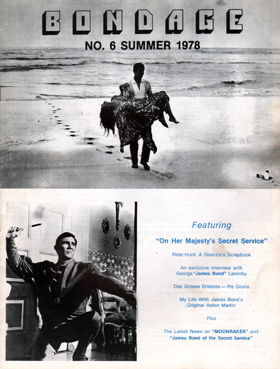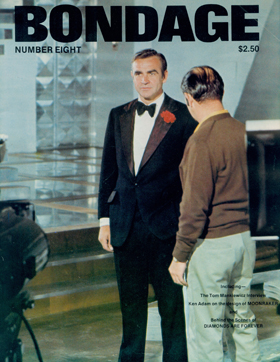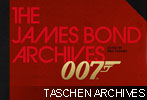Bondage Interview (1)
25th October 2014
MI6 caught up with Richard Schenkman, founder of 'Bondage' magazine - the original Bond fan publication
 By MI6 Staff
By MI6 Staff
As a student Richard Schenkman started the first successful James Bond fan club and magazine, dubbed 'Bondage', in the USA in the 1970s, just as "Live And Let Die" was going into production. Between 1974 to 1989 Schenkman brought behind the scenes news and details to American 007 aficionados, starved of information that their British counterparts could readily read in the UK papers. In the first part of this interview, MI6 spoke to Schenkman about starting the magazine in a pre-internet era, gathering momentum and making the club a success.
How did you get involved in the world of Bond and how did your fan club get started?
We officially started in 1972 or '73. Where it came from was, well, I was a big James Bond fan. I had read all the books over the course of one summer, and seen all the films that were available at the time to see. In the United States, at least, they would get regularly re-released as double features, especially when there was a new film coming. They'd re-release all the old ones to get everyone excited. That was how, in a fairly short span of time, I had been able to see all the films. This was in the year or so preceding the time that "Diamonds are Forever" came out, and then word spread that Roger Moore was going to be the new Bond.
The reason I started the club was simply because nobody else had. That was the only reason. If there were books about James Bond that I could have bought and read, or if there was some kind of fan publication or anything else back in those days, I'd have probably not done it. But I joined the Roger Moore fan club, and it was sort of poems about how handsome Roger Moore was. There was no Sean Connery fan club. I looked at the Baker Street Irregulars, at the idea that there might be a fan club for a fictional character. "There you go," I said, "That's what we should do. We should have a fan club for James Bond."
I called it a fan club, because I thought there needed to be some sort of organisation to it. Of course there were never meetings or people sitting around talking about how much they loved James Bond. It was just a magazine; an excuse to publish these magazines.
My friend Bob and I started it. We started off with this little newsletter, just a little one or two sides of a sheet of mimeograph paper. Then we created a magazine that was really just fifteen or twenty sheets stapled together.
We were able to take that magazine and sell then it in a couple of stores, most notably a store in Greenwich Village called Cinemabilia. Because we could go and sell 20 or 30 copies of this thing, people started to hear about the club and join the club. That made it a more doable proposition.

How did the magazine grow from there?
We traded listings with a few other fan organisations. There was a woman who actually maintained and published a guide to fan groups. In other words, if you wanted to know about the Elizabeth Taylor fan club, you could write to this woman, or buy her listings... You have to remember - and I know it's really hard to picture a time before the internet - but imagine you couldn't just go look things up online. All you could do is go to the magazine store and look for fan magazines, or to the library, looking up old articles in the microfilm or newspapers. That was about it; those were the totality of resources open to people who were fans. Photoplay and other cinema magazines had little ads in the back. So we discovered this organisation of fan clubs, and we placed an ad in Photoplay magazine. And we'd say to other fanzines, "We'll advertise you if you advertise us." People slowly started to hear about it when a couple of other international fan magazines picked us up.
I used to work in my Dad's dry-cleaning store in Greenwich Village. There was a guy that used to come in who was a writer for the New York Daily News and he thought my story was kind of fun, so he did a profile on me. That got some attention, but the thing that really blew it open was, at one point, Playboy magazine picked up on us. They got a kick out of the magazine's name, Bondage, they love a sexy pun like that. They did a little blurb in the Playboy Potpourri section, the sort of one page in the back with little items of interest. "Oh, here's a cool cigarette lighter, here's a cool briefcase." They did a little thing on us, "Hey if you're a Bond fan you can write to these guys and subscribe to their magazine, Bondage." Well, of course, all they had to hear was the term "Bondage" in Playboy, illustrated with a photo of Sean Connery and a couple of topless girls. I think a lot of people assumed that there were going to be nude pictures of the girls from the movies and material like that. Not that I have anything against that, it just wasn't what we did. It wasn't what we had access to.
All of a sudden we got maybe a couple of thousand members from this Playboy thing. With their dues money I was able to enormously improve the quality of the magazine. Now that it looked more like a real magazine, I got get into more shops. I worked with an independent comic book distributor in New York. They took independent magazines like mine on a non-returnable basis. In other words, if the comic book store orders five copies they pay for five copies. It wasn't the usual arrangement where they could send it back. Suddenly now I could sell two or three thousand copies of the magazine and know that the money was mine to have and spend on the production of the magazine. Each issue got better and better because the size of the club grew and the distribution of the magazine grew. I was able to print on better paper and maybe put a colour cover on the magazine and that kind of thing. It kept growing, the quality got better and better. I could have basically turned it into a business but for me it was always a huge labour just to make the thing look like anything. I'm a writer, and graphic design is not my thing.

I had started the thing because I wanted to know more about Bond and there was nowhere to find it. I thought, "I will start it myself and I will do the research." I looked up old articles in microfilm and I contacted British magazines and British newspapers which had materials that had never been published in the United States. I contacted the Bond producers and arranged to go visit the sets and write about them. I sought out people who had materials from the older films and get them to write or provide me with photographs.
It just grew and grew, and it was really fun while it lasted. I met some amazing people - some of whom are still friends to this day. I learned an enormous amount about filmmaking, and publishing, and indie distribution.
I went to college, and graduated, and I got a job working at this new cable TV channel with no name that was just going to play music twenty four hours a day. Ultimately we called it MTV. Eventually, I just ran out of time. Bond was a hobby. I suppose I should have tried to work out a way to make time for it in my life, but I just didn't know if I could. I'd keeping promising people we'd do another issue in six months, but then it became twelve months. I started to feel bad about breaking these promises.
Finally I just said, "One last issue of the magazine, and I'll call it a day." I always wanted to do one more publication because there were bits and pieces that people had sent in over the years that I had never published. I always thought I could do a "Best of Bondage", perhaps including some material from the earliest issues. You see, the print runs on the early issues of the magazine were so small, nobody could possibly have seen them. It wasn't until we got up to Bondage #8 or #9 that we started printing thousands, and I could be reasonably sure that everyone had had access to them. Unfortunately I never did that "Best of" either.

Then years later, people started approaching me; by then the Internet started to be a thing. People contacted me and they said, "Hey, are you going to do anything with this stuff or do you mind if we go and post it online?" I thought, "I never did this to make money, it was always about having the information available." When people asked me about it I said, "Yeah, sure do what you want, but give the writers and artists credit." That's pretty much the story of it.
Thanks to Richard Shenkman. Stay tuned to Mi6 for the second part of the interview.
You Might Also Like
Fan Verdict
Interact Each month, a different James Bond film is selected for review, rating and discussion by the largest online community of 007 fansGet Bond in Your Inbox
Sign up for occasional email updates from MI6. Get notified of breaking Bond news, and digests of recently releases features:







